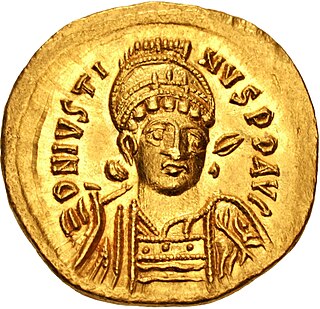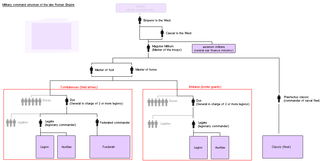Related Research Articles

Justin I, also called Justin the Thracian, was Eastern Roman emperor from 518 to 527. Born to a peasant family, he rose through the ranks of the army to become commander of the imperial guard and when Emperor Anastasius died, he out-maneouvered his rivals and was elected as his successor, in spite of being around 68 years old. His reign is significant for the founding of the Justinian dynasty that included his eminent nephew, Justinian I, and three succeeding emperors. His consort was Empress Euphemia.

Magister militum was a top-level military command used in the later Roman Empire, dating from the reign of Constantine the Great. The term referred to the senior military officer of the empire. In Greek sources, the term is translated either as strategos or as stratelates.

Leontius was Byzantine emperor from 695 to 698. Little is known of his early life, other than that he was born in Isauria in Asia Minor. He was given the title of patrikios, and made strategos of the Anatolic Theme under Emperor Constantine IV. He led forces against the Umayyads during the early years of Justinian II's reign, securing victory and forcing the Umayyad caliph, Abd al-Malik ibn Marwan, to sue for peace.

Tiberius III, born Apsimar, was Byzantine emperor from 698 to 705. Little is known about his early life, other than that he was a droungarios, a mid-level commander, who served in the Cibyrrhaeot Theme. In 696, Tiberius was part of an army sent by Byzantine Emperor Leontius to retake the North African city of Carthage, which had been captured by the Arab Umayyads. After seizing the city, this army was pushed back by Umayyad reinforcements and retreated to the island of Crete. As they feared the wrath of Leontius, some officers killed their commander, John the Patrician, and declared Tiberius the emperor. Tiberius swiftly gathered a fleet and sailed for Constantinople, where he then deposed Leontius. Tiberius did not attempt to retake Byzantine Africa from the Umayyads, but campaigned against them along the eastern border with some success. In 705, former emperor Justinian II, who had been deposed by Leontius, led an army of Slavs and Bulgars from the First Bulgarian Empire to Constantinople, and after entering the city secretly, deposed Tiberius. Tiberius fled to Bithynia, but was captured a few months later and beheaded by Justinian between August 705 and February 706. His body was initially thrown into the sea, but was later recovered and buried in a church on the island of Prote.

Sergiusand Bacchus were fourth-century Syrian Christian soldiers revered as martyrs and military saints by the Catholic, Eastern Orthodox and Oriental Orthodox Churches. Their feast day is 7 October.

The Praetorian Prefecture of Africa was an administrative division of the Byzantine Empire in the Maghreb. With its seat at Carthage, it was established after the reconquest of northwestern Africa from the Vandals in 533–534 by the Byzantine Emperor Justinian I. It continued to exist until 591, when it was replaced by the Exarchate of Africa.
Artabanes was an East Roman (Byzantine) general of Armenian origin who served under Justinian I. Initially a rebel against Byzantine authority, he fled to the Sassanid Persians but soon returned to Byzantine allegiance. He served in Africa, where he won great fame by killing the rebel general Guntharic and restoring the province to imperial allegiance. He became engaged to Justinian's niece Praejecta, but did not marry her due to the opposition of the Empress Theodora. Recalled to Constantinople, he became involved in a failed conspiracy against Justinian in 548/549, but wasn't punished severely after its revelation. He was soon pardoned and sent to Italy to fight in the Gothic War, where he participated in the decisive Byzantine victory at Casilinum.
John Troglita was a 6th-century Byzantine general. He participated in the Vandalic War and served in North Africa as a regional military governor during the years 533–538, before being sent east to the wars with the Sassanid Persians. As dux Mesopotamiae, Troglita distinguished himself in several battles, and was noticed by agents of the Byzantine emperor, Justinian I. In summer 546, Justinian chose John Troglita to assume overall command of Byzantine forces in Africa, where a succession of revolts by the indigenous Moorish tribes and within the imperial army itself had seriously reduced the Byzantine position. Troglita quickly secured an initial victory in the winter of 546/547 against the Moors of Byzacena, but was defeated in summer 547 by the tribes of Tripolitania, and Africa was once again laid open to destructive raids. Troglita reorganized his army and secured the assistance of some tribal leaders, and confronted and decisively defeated the tribal coalition at the Fields of Cato in summer 548. This victory spelled the end of the Moorish revolt and heralded an era of peace for Africa. Troglita was also involved in the Gothic War, twice sending some of his troops to Italy to assist against the Ostrogoths.

The Anastasian War was fought from 502 to 506 between the Byzantine Empire and the Sasanian Empire. It was the first major conflict between the two powers since 440, and would be the prelude to a long series of destructive conflicts between the two empires over the next century.

Mauri was the Latin designation for the Berber population of Mauretania, located in the west side of North Africa on the shores of the Mediterranean Sea, Mauretania Tingitana and Mauretania Caesariensis, in present-day Morocco and northwestern Algeria.
Flavius Areobindus was a general of the Eastern Roman Empire, second generation of Barbarian incorporation of Gothic origin, who became commander in chief of the East. He led battles and conquests on multiple fronts of the allegedly stable Eastern Roman Empire. In addition, due to his military efforts, he was awarded the consulate in 434 along with his co-consul, Aspar. He would hold his magister millitum position until his death in 449. He is the beginning of a distinguished line of nobles through his group’s admission into the Eastern Roman Empire.
Praejecta or Praiecta was a niece to Byzantine emperor Justinian I by blood and of his empress Theodora by marriage.
Solomon was an East Roman (Byzantine) general from northern Mesopotamia, who distinguished himself as a commander in the Vandalic War and the reconquest of North Africa in 533–534. He spent most of the next decade in Africa as its governor general, combining the military post of magister militum with the civil position of praetorian prefect. Solomon successfully confronted the large-scale rebellion of the native Berbers, but was forced to flee following an army mutiny in spring of 536. His second tenure in Africa began in 539 and it was marked by victories over the Berbers, which led to the consolidation of the Byzantine position. A few years of prosperity followed, but were cut short by the rekindled Berber revolt and Solomon's defeat and death at the Battle of Cillium in 544.
Athanasius was a 6th-century Byzantine official who served as envoy and praetorian prefect of Italy and Africa under Emperor Justinian I.

Antalas was a Berber leader of all "Moors" from at least 544 to 548 during the 6th century who played a major role in the wars of the Berbers against the Vandals and Byzantines in Africa having under his leadership the Moorish tribes from all Berbers land from the east Marmarica the region from which come from the Marmarids title of the Libyans tribes who were mainly living at the saharan desert region of northern or middle modern day Libya and Marmarid King "Marmaridum Rex" was a title for Ierna chief of Laguatans and high priest of Gurzil to the entire territory of Mauretania in the west notably having the tribes of Ausi of chief Autilitan, Silvaizan, Macares, Silzactae, Caunes and even others desert tribes such as the known Gaetulians. Antalas and his tribe, the Frexes who lives between modern day Tunisia and Algeria initially served the Byzantines as allies, but after 544 switched sides. With the final Byzantine victory in 548 him and his tribe might have once again became Foederatti for the Byzantines as despite it is not well known he would more likely gets back the state he had before the 2nd Byzantine-Moorish wars of 544-548 CE, the main sources on his life are the epic poem Iohannis of Flavius Cresconius Corippus and the Histories of the Wars of Procopius of Caesarea.
Cutzinas or Koutzinas was a Berber tribal leader who played a major role in the wars of the East Roman or Byzantine Empire against the Berber tribes in Africa in the middle of the 6th century, fighting both against and for the Byzantines. A staunch Byzantine ally during the latter stages of the Berber rebellion, he remained an imperial vassal until his murder in 563 by the new Byzantine governor.
Guntarith, sometimes referred to as Guntharic, was an Eastern Roman military officer and rebel of Vandalic descent.
The Battle of Thacia took place in the autumn of 545, in Thacia. The Byzantine loyalists led by John the Armenian confronted the Berber rebel Antalas and his ally Stotzas, a renegade Byzantine. In the clash, the outnumbered Byzantines were defeated and John was killed, but not before mortally wounding Stotzas. The Byzantine rout triggers a crisis in Carthage.

The Byzantine–Moorish wars were a series of wars fought between the Byzantine Empire and the various Berber kingdoms which formed after the collapse of Roman North Africa. The war also featured other rebels such as the renegades of Stotzas and the Vandalic rebels of Guntarith. The war ended with the Berbers attempting to push the Romans out of Africa being defeated at the battle of the Fields of Cato, and the Byzantines being too weakened to take over the various newly formed kingdoms such as Altava and the Kingdom of the Aurès.
Sergius was a Byzantine military officer who was active in Byzantine Africa during the reign of the emperor Justinian I. The son of a priest named Bacchus, he was the brother of two Byzantine officers and nephew of the famous general Solomon. When appointed governor of Tripolitania, he murdered 80 of the leaders of the Laguatan, which intensified hostilities with the Moorish tribes.